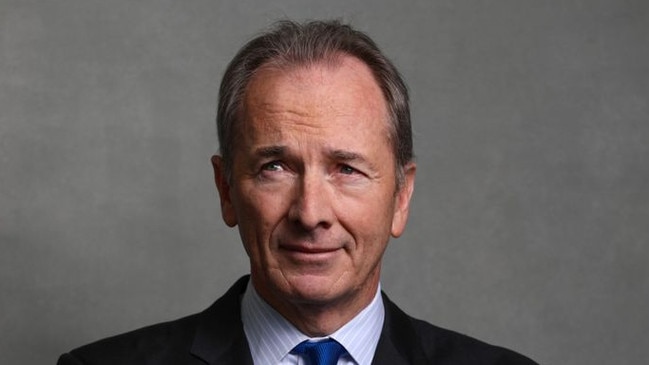Morgan Stanley’s James Gorman to step down as CEO
The Australian-born Wall Street chieftain, one of the longest-serving of US big-bank CEOs, says he expects his successor to be named within 12 months.

James Gorman said he is stepping down as chief executive at Morgan Stanley in the next year, marking an end to a 13-year run in which he overhauled the Wall Street bank and on some measures overtook rival Goldman Sachs.
Australian-born Mr Gorman said at an annual shareholders meeting on Friday (Saturday AEST) that he expects a new CEO to be chosen within the next 12 months.
Mr Gorman said that the board has identified three strong senior candidates to be the next chief. Mr Gorman said he would become executive chairman for a period after the new CEO takes over.
One of the longest-serving of US big-bank CEOs, Mr Gorman took the chief’s reins at Morgan Stanley in 2010 and became chairman in 2012. The expected transition that Mr Gorman spelled out on Friday is similar to the departure of Morgan Stanley’s prior chief, John Mack, who stayed on as chairman during the first two years of Mr Gorman’s tenure.
Mr Gorman said he and the board believe this setup “will ensure the continued stability of Morgan Stanley” while positioning it for growth under new leadership.
Executives who are viewed as the most likely to replace Mr Gorman include Andy Saperstein, co-president and head of wealth management; Ted Pick, co-president and head of institutional securities and co-head of corporate strategy, and Dan Simkowitz, head of investment management and co-head of corporate strategy.
Succession planning at Morgan Stanley has been under way for some time. A 2021 reshuffling set up a four-way race that also included Jonathan Pruzan, who was chief operating officer until he retired in January.

Mr Gorman has transformed Morgan Stanley from a firm whose risk-taking meant it barely survived the 2008 financial crisis into a leading wealth-management institution, whose diversification helps to offset lulls in deal making and trading. The European debt crisis in 2011 called Morgan Stanley’s viability into question once again over concerns about its exposure to troubled European debt.
“As someone who lived through the darkest days of 2008 where Morgan Stanley was seen as part of the problem, it’s indeed rewarding to be here 14 years later as part of the solution,” he said in April after the bank helped provide some cash to First Republic, a regional bank that was then teetering and later failed.
The only other big bank chiefs still in their posts from the financial crisis are JPMorgan Chase’s Jamie Dimon and Bank of America’s Brian Moynihan.
Mr Gorman has spent much of his tenure raising capital levels, slashing pay, exiting risky businesses and shrinking the trading operation – while pushing the firm deeper into wealth management. In the process, he pulled Morgan Stanley ahead of many US banks.
Morgan Stanley shares are up 184 per cent since Mr Gorman took over, compared with the 82 per cent increase in the KBW Nasdaq Bank Index. That is behind the stock rise of JPMorgan Chase over the same period, but better than Goldman Sachs.
Morgan Stanley has also jumped ahead of Goldman in terms of its market value; it is worth around $US140 billion, while its rival is at about $US110 billion.
Success didn’t occur overnight, and Mr Gorman encountered many doubters in the process of building out its wealth-management operation, which he often called “ballast” that would help the firm stay steady when market storms roiled its trading business.
He spearheaded Morgan Stanley’s acquisition of Smith Barney from Citigroup, which began in 2009 and was completed in 2013. The deal would turn out to be a significant milestone in turning the Wall Street bank into a powerhouse in wealth management.
In 2019, Morgan Stanley bought Solium Capital, which manages the stock that corporate employees receive as part of their pay, and in 2020 it pushed into retail investing with its acquisition of E*Trade. Its wealth-management unit accounted for about 45 per cent of revenue in the first quarter of 2023.
Days after completing its acquisition of E*Trade, Morgan Stanley announced it was buying Eaton Vance, expanding its footprint in fund management.
On the bank’s last earnings call, Mr Gorman signalled there is more to come. He said Morgan Stanley’s wealth-management unit in the US is “going to be an asset-gathering monster,” adding there was no doubt that the bank would do more acquisitions in wealth and asset management.
Morgan Stanley’s bet on wealth management preceded a later move by Goldman Sachs to diversify its revenues by entering into consumer lending. Goldman is now pulling back on much of that effort after posting billions of dollars in losses and is working to diversify its revenue streams by building out existing asset and wealth-management businesses.
Goldman’s path to doing that largely mirrors what Morgan Stanley has accomplished: bringing in steady revenue streams to offset ebbs and flows in traditional Wall Street businesses.
Mr Gorman’s tenure hasn’t been without missteps. The bank is in the midst of trying to settle a high-profile block-trading investigation. It recently disclosed that it is in discussions to try to settle investigations by the Securities and Exchange Commission and the Justice Department into whether its bankers improperly alerted favoured clients to block-trading sales befores they were publicly disclosed.
In 2021, it revealed $US911 million in trading losses tied to the implosion of Archegos Capital Management. Much of the bank’s losses resulted from collateral it sold at lower values after Archegos was unable to repay its margin loans.
Overall, though, Mr Gorman’s tenure was viewed as a success and his strategic vision has been embraced by many other banks both in the US and abroad.
“It’s the end of an era,” said Mike Mayo, a Wells Fargo analyst who covers Morgan Stanley, adding “James Gorman turned around Morgan Stanley.”
Most notable about his time as CEO, Mayo said, is the shift from the scepticism that Mr Gorman received during the early stages of his tenure from employees throughout Morgan Stanley’s ranks and shareholders. “Investors were saying he’s not a banker or a trader, he’s a consultant, he doesn’t know what he’s doing – and now here we are more than a decade later looking at his results with other banks thinking how can we replicate that.”
In perhaps the most fitting tribute to a Wall Street chieftain, Morgan Stanley’s stock closed down 2.7 per cent on Friday on the news of his pending departure.
The Wall Street Journal







To join the conversation, please log in. Don't have an account? Register
Join the conversation, you are commenting as Logout